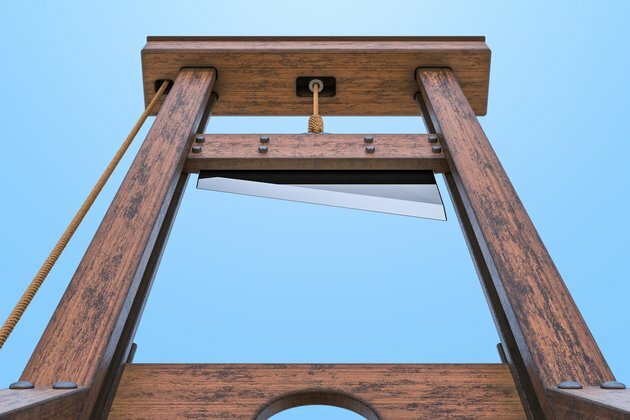Why the guillotine may be less cruel than execution by slow poisoning
The Conversation
16 Oct 2019, 17:52 GMT+10

Concerns about the drugs used for executions are being raised again after the federal government announced it will once again execute inmates convicted of capital crimes almost 16 years after the last execution was carried out.
International drug companies will no longer sell drugs for use in lethal injections in the United States. But Attorney General William Barr has authorized the federal justice system to use the widely available drug pentobarbital, despite concerns about whether that method violates the Eighth Amendment, which prohibits cruel and unusual punishment. In common use, the drug controls seizures in humans and is often used to euthanize pets.
In 2014, several executions carried out by states with untested methods using a mixture of drugs caused suffering and took hours to end prisoners' lives.
Among them was the botched execution of Oklahoma inmate Clayton Lockett, who thrashed around in pain for 43 minutes before dying, prompted President Obama to call for a moratorium on the death penalty for federal inmates.
While the death penalty is the ultimate punishment meted out by the state, it is not meant to be torture.
From the stake to the rope to the firing squad to the electric chair to the gas chamber and, finally, to the lethal injection, over the centuries the methods of execution in the United States have evolved to make execution quicker, quieter and less painful, both physically and psychologically.
It wasn't always so. And there are, perhaps, lessons in history that could provide an answer to current concerns about the unusual cruelty of execution methods in the U.S.
Spectacles of physical torment
Under the French monarchy in the 17th and 18th centuries, execution was meant to be painful. That would purify the soul of the condemned before his final judgment, deter others from committing crime, and showcase the power of the king to impose unbearable suffering on his subjects.
Public executions were spectacles that were part public holiday, part grim warning. Crowds gathered to watch the prisoner endure physical torments almost too dreadful to imagine: hot pokers, boiling lead poured into wounds, dismembering hooks, and of course, the horses readied to draw and quarter.
Not everybody suffered so terribly, however. This parade of horrors was the fate of commoners. For nobles, a quick, relatively painless, and more dignified beheading replaced an hours-long public display.
One of the many goals of the French Revolution, which took place from 1789 to 1815, was to level society, to take away the privileges of the nobility, who lorded over commoners.
The solution to disparate forms of execution and social equality was first presented to the French National Assembly on Oct. 10, 1789 by Dr. Joseph Guillotin, who presented plans for a bladed machine to execute criminals.
It would be easy to use, work quickly and offer the same treatment to all condemned, regardless of social standing. His ideas finally became law in March 1791 and the guillotine was used for an execution the following year.
The so-called "national razor" took off the heads of the royal family as well as the humblest thief. It leveled bodies and society, with all citizens subject to the same punishment. And it ended the capricious torment of the condemned by the monarchy as well as the privilege that nobles had, even regarding the manner of their deaths.
The guillotine was a killing machine that provided not just a convenient method of execution but the proper political and ideological message for the Revolution.
Less cruel and unusual?
Eventually, the French Revolution became more politically radical, moving from a system where the king would continue to govern within a constitutional system to a republic where the people's representatives would wield political power to a de facto dictatorship. As the Revolution became more radical, and politicians saw plots everywhere, increasing numbers of citizens were sentenced to death.
With the need to execute many prisoners the guillotine was pressed into greater use. The most careful estimate for the number of French executed during the Terror, the height of the radical Revolution, was 17,000. This number included almost exclusively those charged with political crimes.
It was the guillotine's plummeting blade that took off head after head with just a bit of cleaning and sharpening in between, answering the need of the moment. Thus it came to symbolize state terrorism but also swift and equal justice.
The guillotine remains a quick method of execution - it takes about half a second for the blade to drop and sever a prisoner's head from his body.
While the moment of execution could be nothing but terrifying, that second of suffering was brief in comparison to the 43 minutes it took for Lockett to die after lethal drugs were administered.
In the same year, 2014, convicted double murderer Joseph Rudolph Wood of Arizona suffered for two hours before succumbing to the jerry-built drug cocktail dreamed up in a warden's office. In 2018, an Alabama execution had to be halted after 12 attempts to place an IV line in Doyle Hamm failed.
The current technology of execution does not reliably provide the humane death demanded by the Constitution. In requiring an IV line and medical personnel to administer drugs it also involves medical practice with the death penalty.
Although the guillotine may be the bloodiest of deaths - the French used sand bags to soak up the blood - it does not cause the prolonged physical torment increasingly delivered by lethal injections.
Should the U.S. consider using the guillotine to administer capital punishment?
It has advantages - no secret recipes for lethal injections, no botched placement of IV needles, no conflation of medicine and execution.
While the guillotine provides a death that is not easy to witness, the death it delivers to the condemned is quick and does not cause the extended pain of bespoke lethal injections.
Could such a death, as bloody as it is, pass muster with the Eighth Amendment's mandate against cruel and unusual punishment?
Author: Janine Lanza - Associate Professor of History, Wayne State University 
 Share
Share
 Tweet
Tweet
 Share
Share
 Flip
Flip
 Email
Email
Watch latest videos
Subscribe and Follow
Get a daily dose of Arizona Herald news through our daily email, its complimentary and keeps you fully up to date with world and business news as well.
News RELEASES
Publish news of your business, community or sports group, personnel appointments, major event and more by submitting a news release to Arizona Herald.
More InformationBusiness
SectionWall Street diverges, but techs advance Wednesday
NEW YORK, New York - U.S. stocks diverged on Wednesday for the second day in a row. The Standard and Poor's 500 hit a new all-time...
Greenback slides amid tax bill fears, trade deal uncertainty
NEW YORK CITY, New York: The U.S. dollar continues to lose ground, weighed down by growing concerns over Washington's fiscal outlook...
Taliban seeks tourism revival despite safety, rights concerns
KABUL, Afghanistan: Afghanistan, long associated with war and instability, is quietly trying to rebrand itself as a destination for...
Nvidia execs sell $1 billion in stock as AI boom drives record prices
SANTA CLARA, California: Executives at Nvidia have quietly been cashing in on the AI frenzy. According to a report by the Financial...
Tech stocks slide, industrials surge on Wall Street
NEW YORK, New York - Global stock indices closed with divergent performances on Tuesday, as investors weighed corporate earnings, central...
Canada-US trade talks resume after Carney rescinds tech tax
TORONTO, Canada: Canadian Prime Minister Mark Carney announced late on June 29 that trade negotiations with the U.S. have recommenced...
Phoenix
SectionTrump hints at DOGE investigation of Musk subsidies
WASHINGTON, DC - U.S. President Donald Trump on Tuesday claimed Elon Musk's success has been built on government subsidies. Without...
Fox faces $787 million lawsuit from Newsom over Trump phone call
DOVER, Delaware: California Governor Gavin Newsom has taken legal aim at Fox News, accusing the network of deliberately distorting...
How China's Hefei incubates future industries from frontier science
by Xinhua writers Yao Yuan and Cheng Yunjie HEFEI, July 2 (Xinhua) -- Residents of Hefei say the city has two suns -- one suspends...
Bengals 2025 Opponent Preview: Pittsburgh Steelers
Michael Hull Over the course of the next few weeks, we will be taking an in-depth look at the Bengals' 2025 opponents. Next up, the...
Opponent offseason update: Arizona Cardinals
CHARLOTTE Now that it's July, we're officially in the ramp-up to training camp and the start of the 2025 season. So now's a good...
From CFL To NFL, Elliott Brown Is On A Mission
Outside linebacker tied for sack lead last season Zach Gershman WhenElliott Brownwas playing football in another country, the destination...













